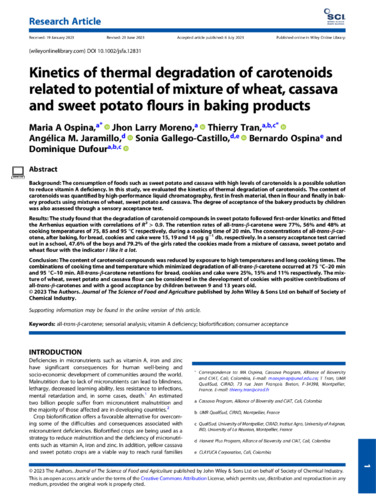Kinetics of thermal degradation of carotenoids related to potential of mixture of wheat, cassava and sweet potato flours in baking products
BACKGROUND The consumption of foods such as sweet potato and cassava with high levels of carotenoids is a possible solution to reduce vitamin A deficiency. In this study, we evaluated the kinetics of thermal degradation of carotenoids. The content of carotenoids was quantified by HPLC, first in fresh material, then in flour, and finally in bakery products using mixtures of wheat, sweet potato and cassava. The degree of acceptance of the bakery products by children was also assessed through a sensory acceptance test. RESULTS The study found that the degradation of carotenoids compounds in sweet potato followed first-order kinetics and fit the Arrhenius equation with correlations of R2>0.9. The retention rates of all-trans-β-carotene were 77%, 56% and 48% at the cooking temperatures of 75°, 85° and 95°C respectively, during a cooking time of 20 min. The concentrations of all trans-β-carotene, after baking, for bread, cookies, and cake were 15, 19 and 14 μg/g db, respectively. In the sensory acceptance test carried out in a school, 47.6% of the boys and 79.2% of the girls rated the cookies made from a mixture of cassava, sweet potato, and wheat flour with the indicator, I like it a lot. CONCLUSION The content of carotenoids compounds was reduced by exposure to high temperatures and long cooking times. The combinations of cooking time and temperature which minimized degradation of all-trans-β-carotene occurred at 75°C-20 min and 95°C-10 min. All trans-β-carotene retentions for bread, cookies and cake were 25%, 15% and 11% respectively. The mixture of wheat-sweet potato-cassava flour can be considered in the development of cookies with positive contributions of all trans-β-carotenes and with a good acceptance by children between 9 and 13 years. This article is protected by copyright. All rights reserved.

